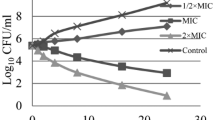Abstract
Sodium azide (6 mg/ml) was used as a positive control for drug-induced lethality in an in vitro clonogenic assay. Petri dishes containing control and sodium azide treated cultures of WiDr cells were placed together in a large Petri dish and incubated at 37°C in an atmosphere of 10% CO2 in air. No growth was observed. Control cells formed colonies only when the dishes were separated from the sodium azide dishes. Using a microtiter plate the toxic effect was inversely related to the distance of the test cultures from the sodium azide treated cultures. These results suggested the formation of a toxic gas or vapour from sodium azide under cell culture conditions, probably an azide. Chemical analysis was based on characteristic reactions, such as the production of a precipitate with silver ions or formation of a red-coloured complex with ferric salts. On a microtiter plate, a gradient of the expected precipitate or red colour was observed, the highest amounts adjacent to the wells containing sodium azide.
These results show that sodium azide acts as a positive control of drug-induced lethality for in vitro clonogenic assays. However, the formation of a highly toxic vapour, most likely hydrazaic acid, makes it a less suitable standard.
Similar content being viewed by others
References
Salmon SE, Lin R, Hayes C, Persaud J, Roberts R: Usefulness of abrin as a positive control for the human tumor clonogenic assay. Invest New Drugs 1:277–281, 1983
Sondak VK, Hildebrand-Zanki SU, Kern DH: Inhibitory effects of sodium azide on adjacent, untreated wells in a rapid chemosensitivity assay. In: SE Salmon and JM Trent (eds): Human Tumor Cloning. Grune and Stratton, Inc, (Abstract) 1984, p680
Shoemaker RH, Wolpert-DeFilippes MK, Kern DH, Lieber MM, Makuch RW, Melnick NR, Miller WT, Salmon SE, Simon RM, Venditti JM, Von Hoff DD: Application of a human tumor colony-forming assay to new drug screening. Cancer Res 45:2145–2153, 1985
Noguchi P, Wallace R, Johnson J, Earley EM, O'Brien S, Ferrone S, Pellegrino MA, Milstien J, Needy C, Browne W, Petricciani J: Characterization of WiDr: A human colon carcinoma cell line. In Vitro 15:401–408, 1979
Van Lambalgen, R, Lelieveld P: submitted
Jones K: Nitrogen. In: JC Bailar, HJ Emeléus, Sir R Nyholm, AF Trotman-Dickenson (eds): Comprehensive Inorganic Chemistry. Pergamon Press, Oxford, 1973, pp 147–388
Kern DH, Drogemuller CR, Kennedy MC, Hildebrand-Zanki SU, Tanigawa N and Sondak VK: Development of a miniaturized, improved nucleic acid precursor incorporation assay for chemosensitivity testing of human solid tumors. Cancer Res 45:5436–5441, 1985
Author information
Authors and Affiliations
Rights and permissions
About this article
Cite this article
Lelieveld, P., Aapro, M.S., van Lambalgen, R. et al. Sodium azide is less suitable as a positive control of drug-induced lethality for in vitro clonogenic assays. Invest New Drugs 4, 367–371 (1986). https://doi.org/10.1007/BF00173509
Issue Date:
DOI: https://doi.org/10.1007/BF00173509




